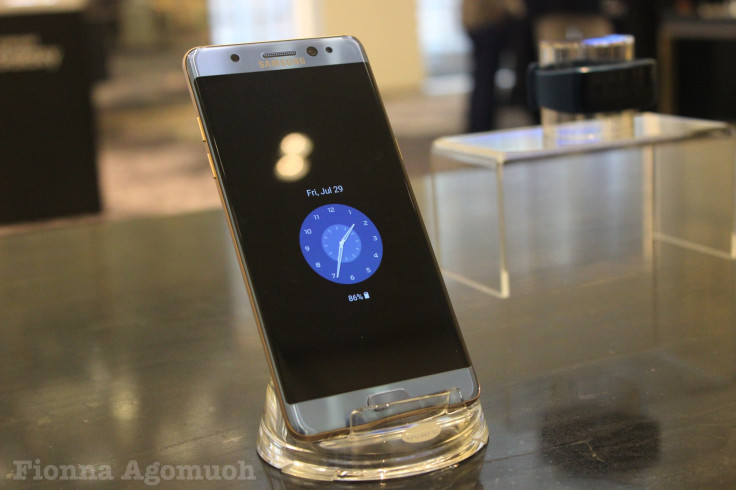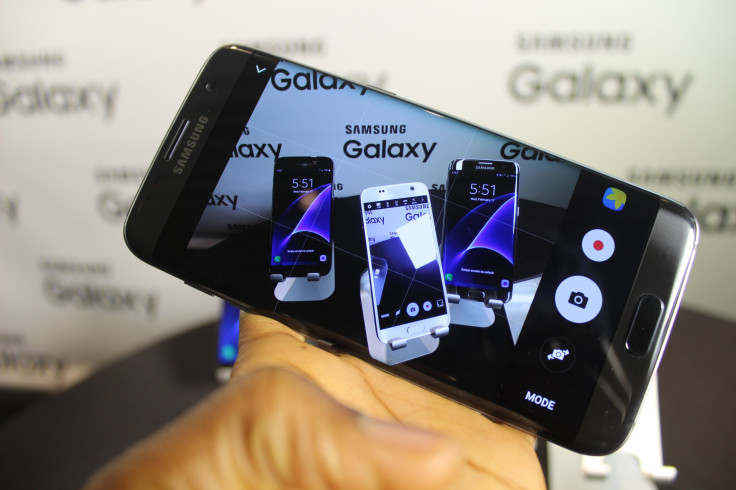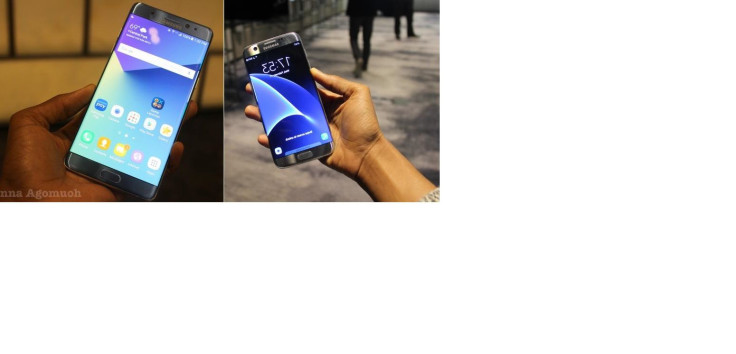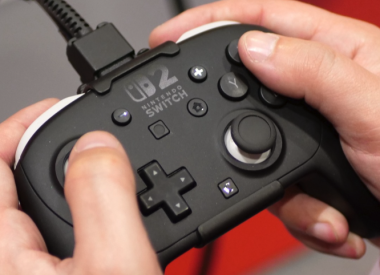It appears seven is Samsung’s lucky number in 2016. The manufacturer released the Galaxy S7 and S7 Edge earlier this year and announced the Galaxy Note 7 in early August. The S7 and S7 Edge are on track to sell 25 million units by the end of the year, as of June, while the Galaxy Note 7 is expected to beat the S7 and S7 Edge in sales by the same time.
Together all three devices are helping Samsung recover from a sales slump, which hit an all-time low in 2014, with the Galaxy S5 selling fewer handsets than the Galaxy S4.
The Galaxy Note 7 and Galaxy S7 Edge prime examples of Samsung’s evolution as a premium brand. Both devices feature Samsung’s standout dual-edge display and new color options.
Here’s a rundown of the Galaxy Note 7 and Galaxy S7 Edge features and how they compare. Can’t decide between the phablet and the larger phablet? Let us make the choice easier.


Display
The 5.7-inch Quad HD (2560 x 1440 resolution) display on the Galaxy Note 7 is considered the best screen on a smartphone today, according to DisplayMate. The screen features dual-edge curves, similar to the Galaxy S7 Edge, and a pixel density of 518 ppi, similar to the Galaxy Note 5. Samsung has introduced a Gorilla Glass 5 case for the Galaxy Note 7, which is expected to be able to withstand damage from a shoulder-height drop.
The Galaxy S7 Edge features a 5.5-inch Quad HD display and is protected by Gorilla Glass 4. The smartphone also includes a dual-edge display and a pixel density of 534 ppi. Despite the higher pixel density, which used to be an indicator of visual quality and whether individual pixels could be seen by the naked eye. However, the Galaxy Note 7 wins for better power efficiency relative to its size, which is slightly larger than the S7 Edge, according to DisplayMate.
Both smartphones include on-screen edge features, which can be accessed by swiping the Edge tab on the right side of the curved screen. Users can also configure the tab to be on the left if they choose.
Hardware
The Galaxy Note 7 will ship in two processor models, one with the Qualcomm Snapdragon 821 chip and one with the Exynos 8890 chip. Memory consists of 4GB RAM and 64GB of internal storage. There is also a limited availability model, which will have 6GB of RAM and 128GB of internal storage. MicroSD expansion on the device supports cards up to 256GB.
The Galaxy S7 Edge features the Qualcomm Snapdragon 820 chip and the Exynos 8890 chip depending on the model. It include 4GB of RAM and 32GB and 64GB intern storage options and MicroSD expansion up to 200GB.
The Galaxy Note 7 features a 3,500mAh battery , while the Galaxy S7 Edge features a 3,600mAh battery. Both devices have some of the largest batteries found on a Samsung device; however, the Note 7 battery is smaller, despite being the larger of the two, because of its S-Pen.
Samsung told iDigitalTimes the S-Pen took up space in the Galaxy Note 7 that could have otherwise been used for battery capacity. However, the manufacturer plans to add software boosts to ensure performance does not lag as a result of this design choice.
Design
The Galaxy Note 7 is the first Note smartphone to feature a dual-edge smartphone with an S-Pen together. During the 2015 launch of the Galaxy S6 Edge+, Samsung told iDigitalTimes that the smartphone couldn’t include both features because that would make it too expensive. The S6 Edge+ is slightly pricier than the Note 7.
The S6 Edge+ was Samsung’s first dual-edge phablet, which made the way for the Galaxy S7 Edge. The manufacturer refined the S7 Edge look with more dramatic curves to support more usable screen space an and a smaller body overall, then brought a similar look to the Galaxy Note 7. Both devices include edge-based software features; however, the Galaxy Note 7 has edge features that accompany its S-Pen.
The Galaxy Note 7 features a USB Type-C port, while the Galaxy S7 Edge features a Micro USB port. In the past, Samsung suck to Micro USB to continue compatibility between its smartphones and its Gear VR headset. However, with the launch of the Galaxy Note 7, the manufacturer has also introduced a new Gear VR, which supports USB Type-C and is also backwards compatible with Micro USB connectors.
Galaxy Note 7 color options include Black Onyx, Silver Titanium and Blue Coral as well as Gold Platinum, which will only be available outside the U.S.. Galaxy S7 Edge color options include Black Onyx and Gold Platinum, with white, pink and silver options available in specific markets.
Camera
Both the Galaxy Note 7 and Galaxy S7 Edge feature a 12-megapixel rear camera and 5-megapixel front camera, both featuring f/1.7 aperture. Other camera features on both devices include 4K video. The Galaxy Note 7 introduces HDR video.
Software
The Galaxy Note 7 runs Android 6.0.1 Marshmallow, with Samsung’s TouchWiz interface. New features to Touchwiz include uniformly rounded icons and motion wallpaper, new camera shortcuts and a Secure Folder. New S-Pen features for the Galaxy Note include an animated GIF creator, and an always-on display, which allows users to pin notes.
The Galaxy S7 Edge currently runs Android 6.0 Marshmallow, but launched with Android 5.1 Lollipop. The smartphone includes edge software features such as the apps edge, which is a shortcut to users’ favorite apps, a people edge for favorite contacts, a weather edge, stocks edge, sports edge and many others. Users can also create their own edge panels and include third party apps. The Galaxy Note 7 also includes similar edge software.
Special Features
The Galaxy Note 7 introduces an iris scanner, which lets users unlock and authenticate their device with their eyes. This is a second biometric option, in addition to the fingerprint scanner. Users can set up both their irises and fingerprints to use for different functions. The iris scanner was particularly designed to work with Secure Folder. The Galaxy S7 Edge also includes fingerprint authentication. It’s edge software and always-on display (also found on the Galaxy Note 7) also count as special features.
Both the Galaxy Note 7 and Galaxy S7 Edge feature IP68 water, wind and dust resistance, meaning the devices can survive in up to 5 feet of water for up to 30 minutes. The Galaxy Note 7 S-Pen is also rated IP68, meaning users should be able to take both the handset and stylus underwater and use them normally.
Price and Availability
The Galaxy Note 7 was announced Aug. 2 in New York City and is currently available for preorder. The device will go on sale Aug. 19 , selling for around $849. It will be available at carriers including Verizon, T-Mobile, AT&T, Sprint and U.S. Cellular and retailers including Amazon.com, BestBuy.com, Car Toys, Sam’s Club, Target and select Walmart stores.
The Galaxy S7 Edge was announced in February in Barcelona and has been available since April, selling for around $749.99. It is available at carriers including Verizon, T-Mobile, AT&T, Sprint and U.S. Cellular and retailers including Best Buy, Amazon and Costco.

















